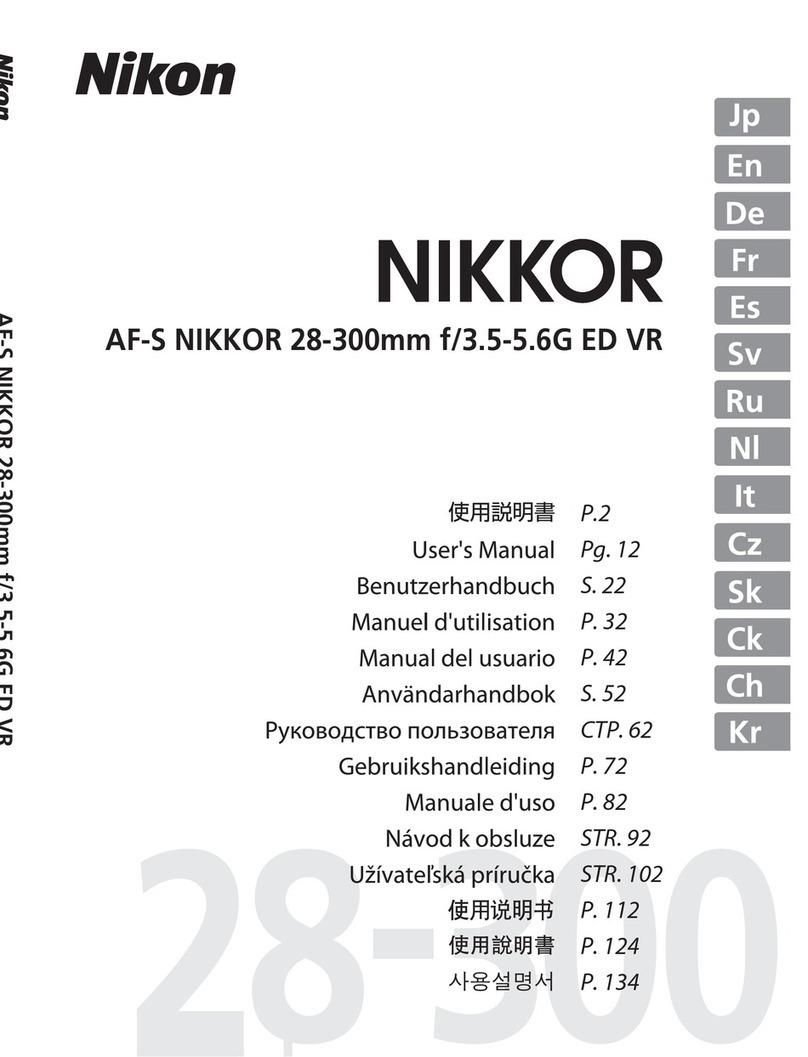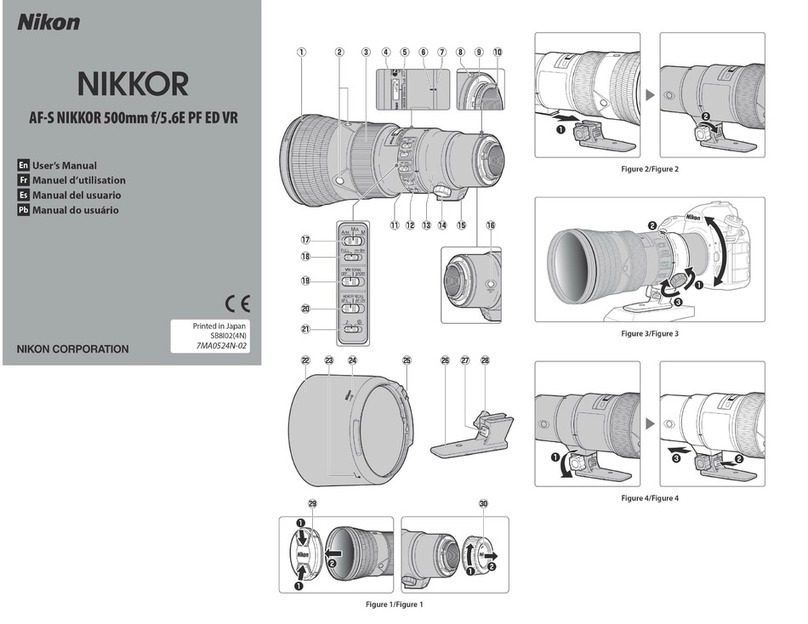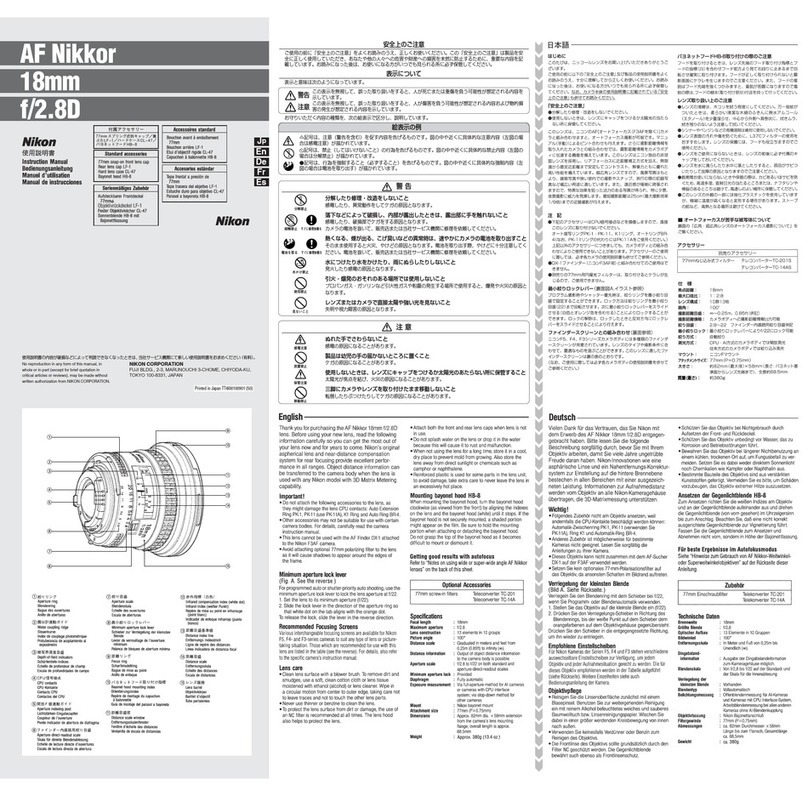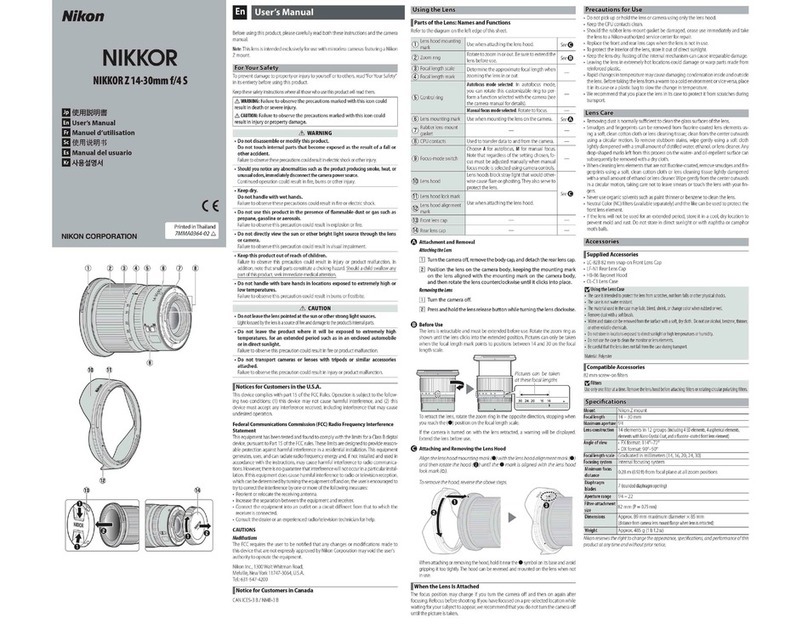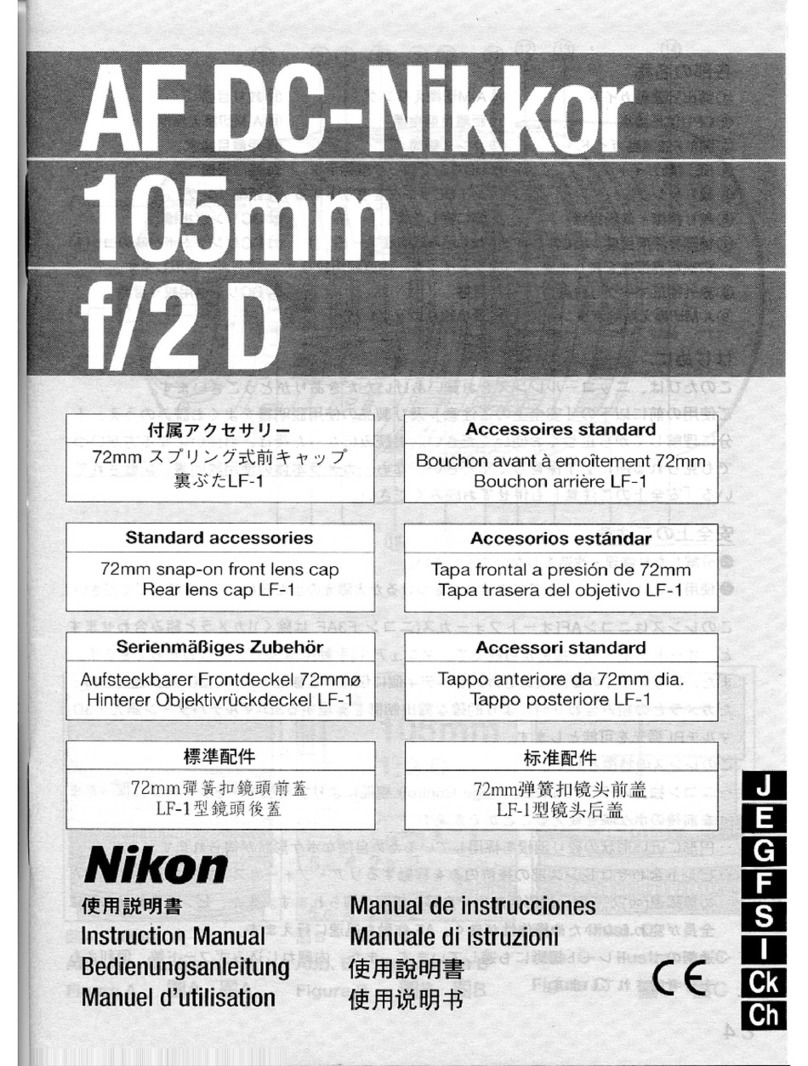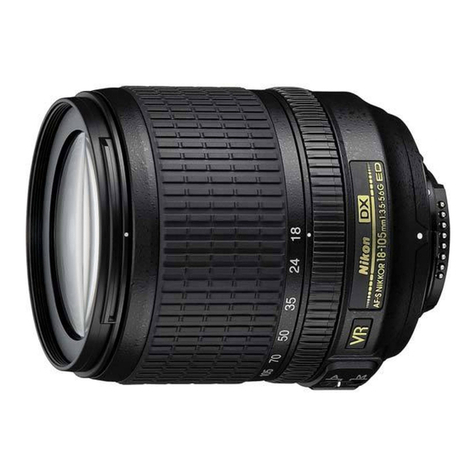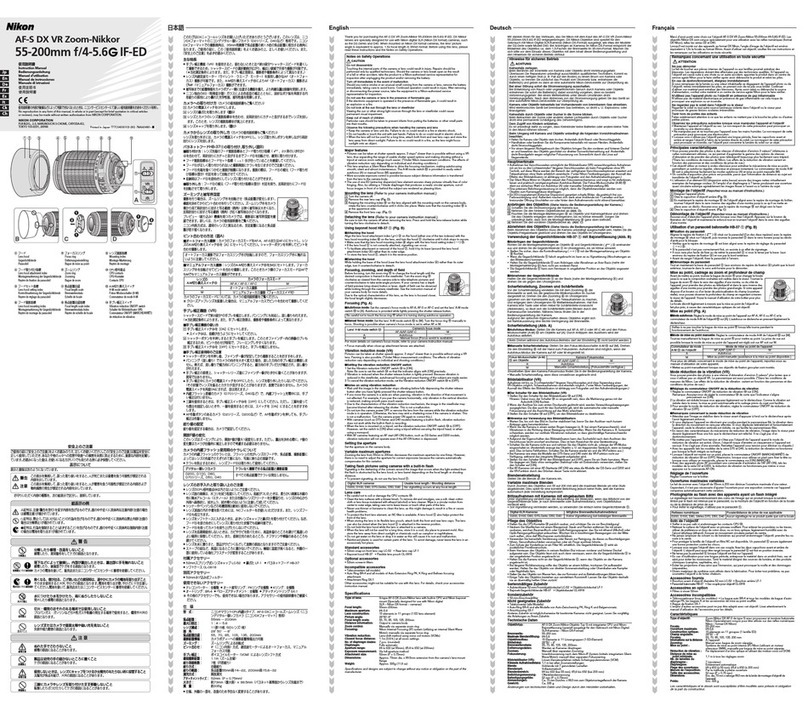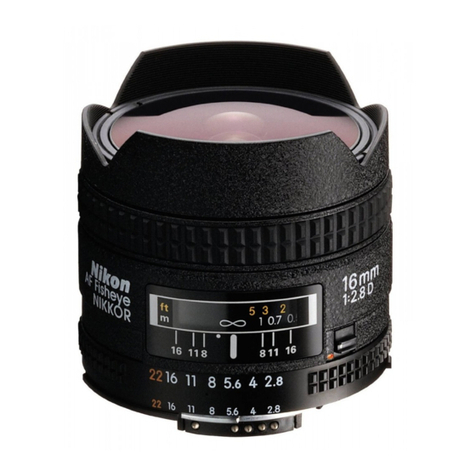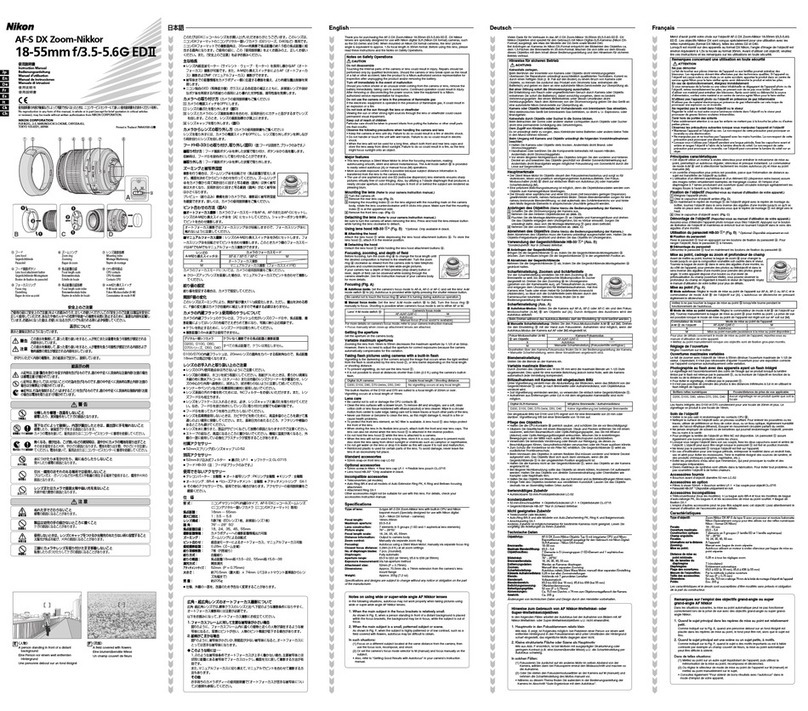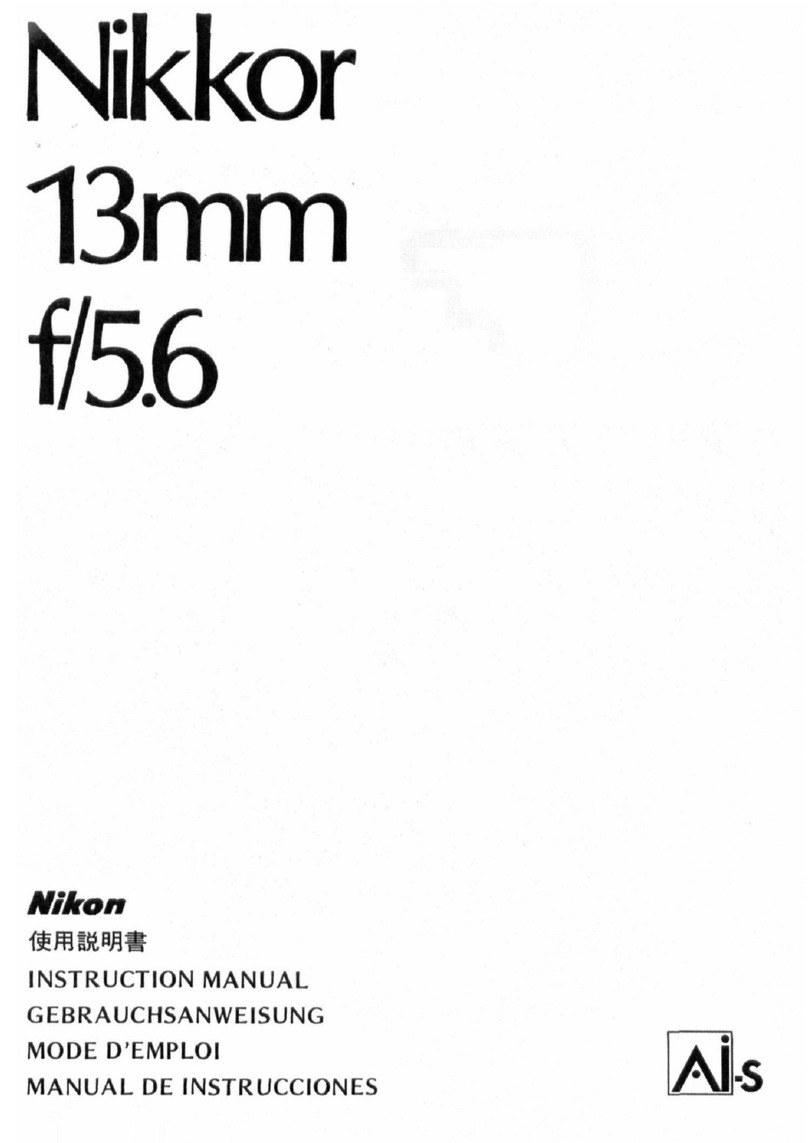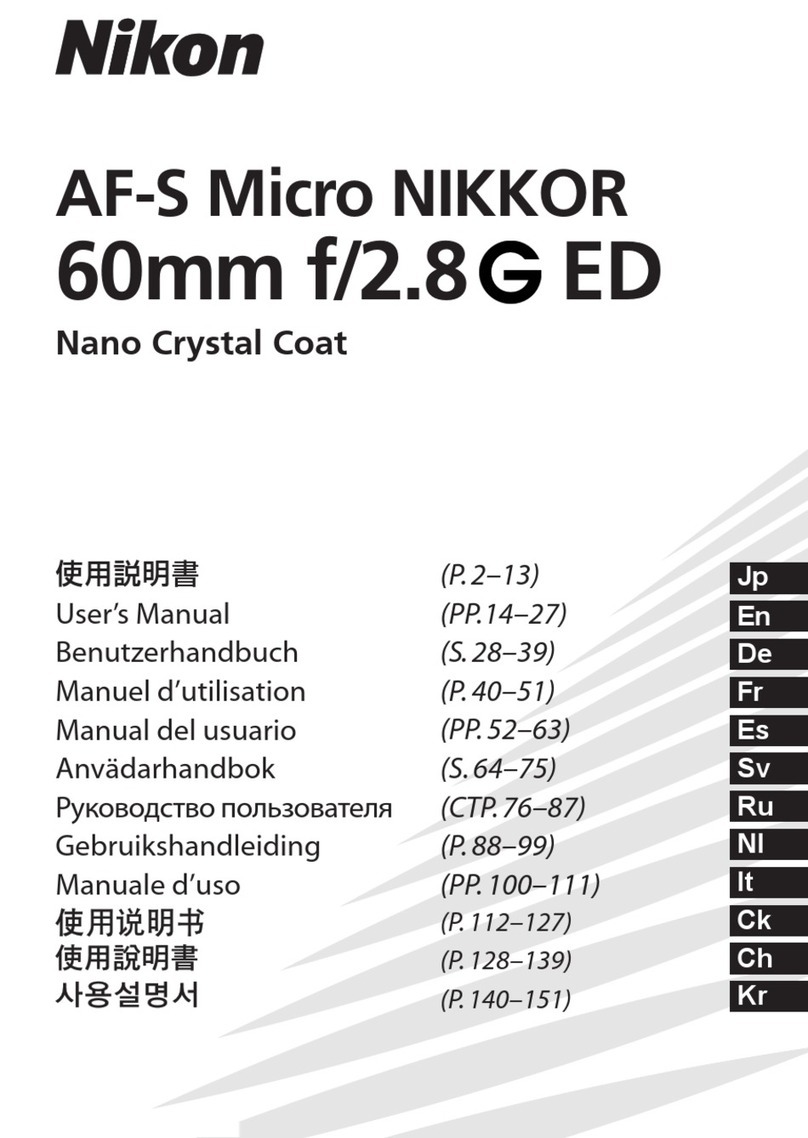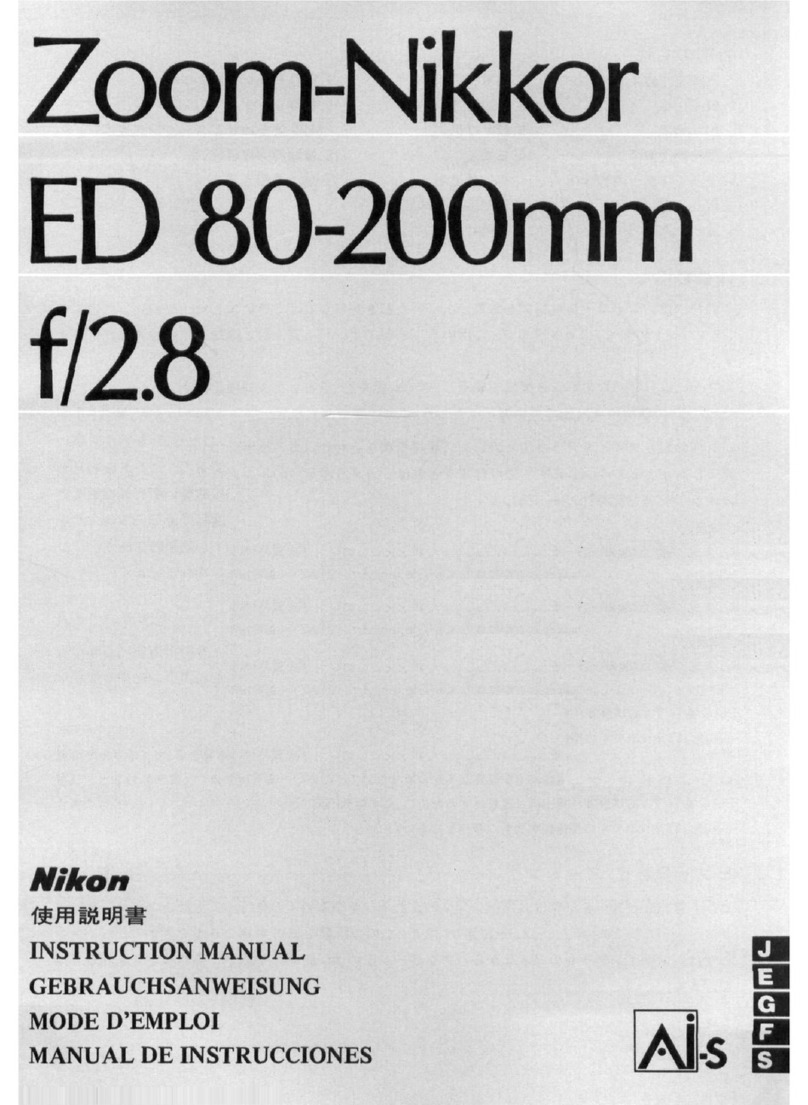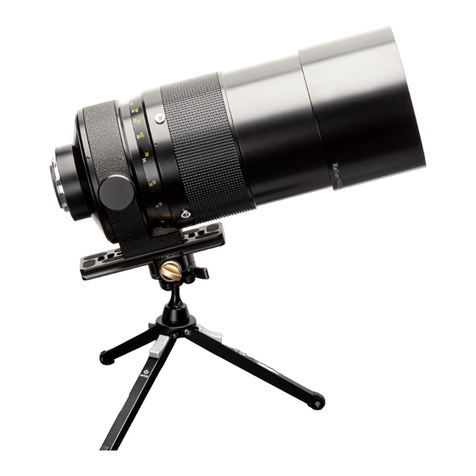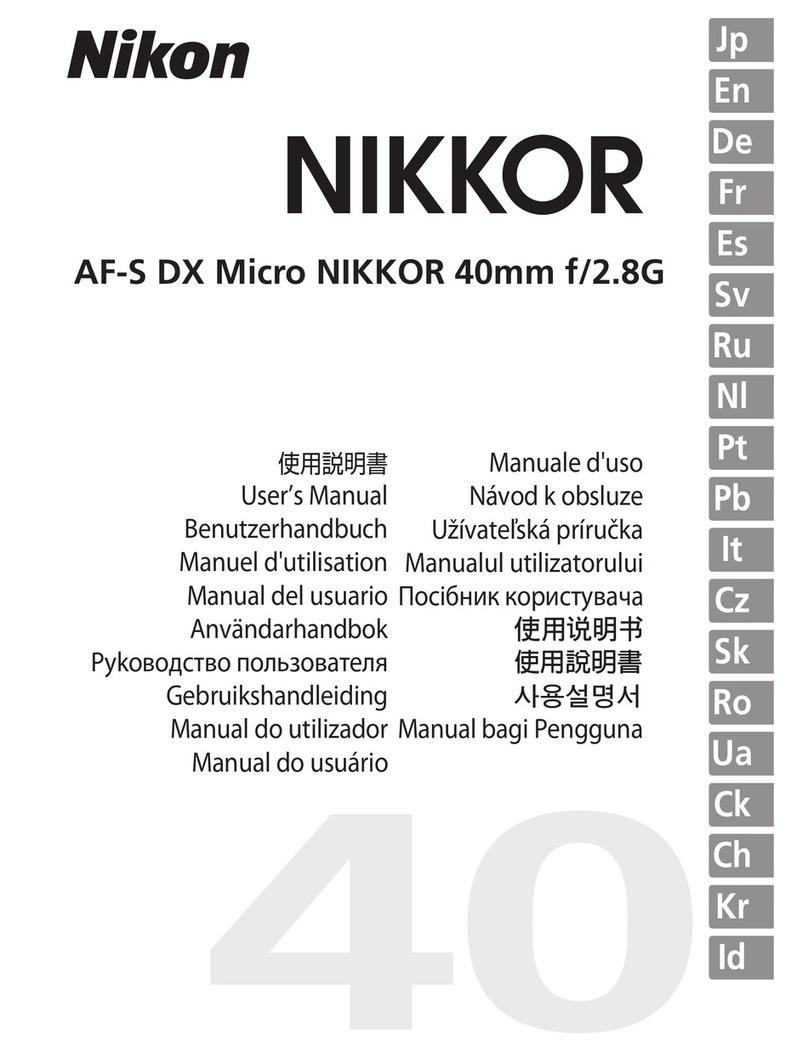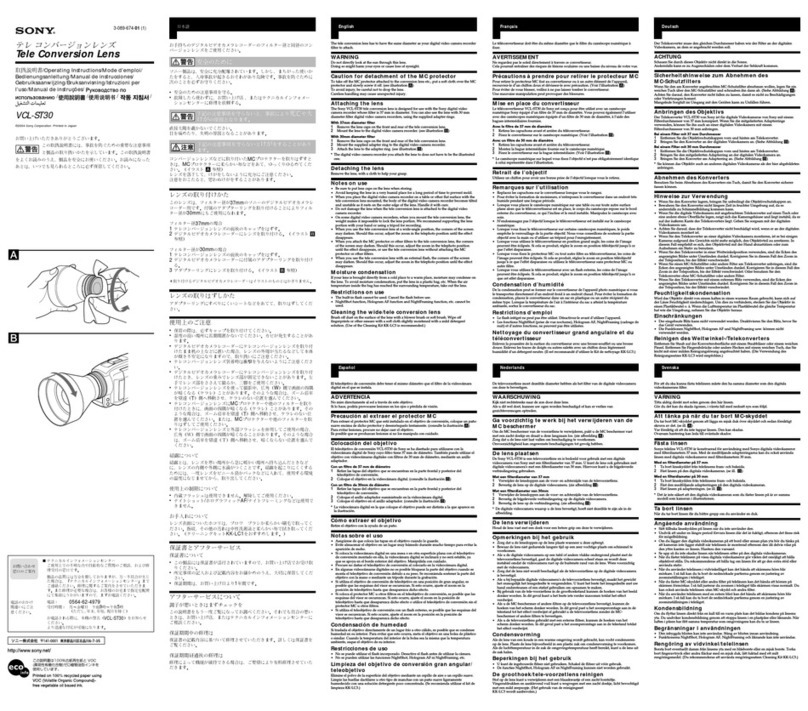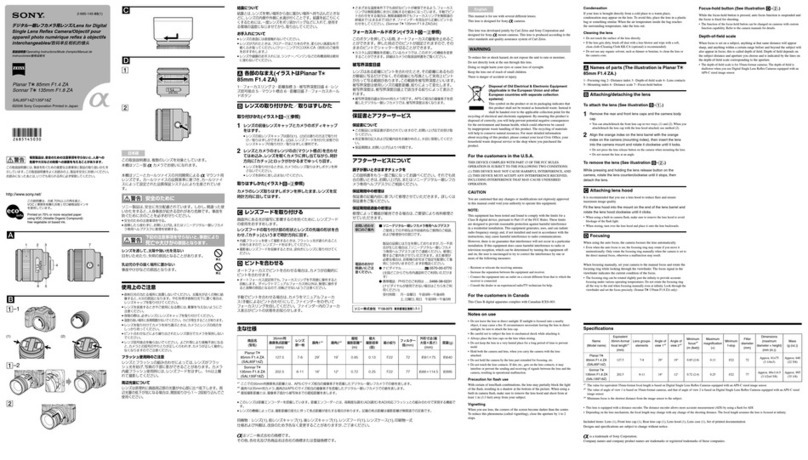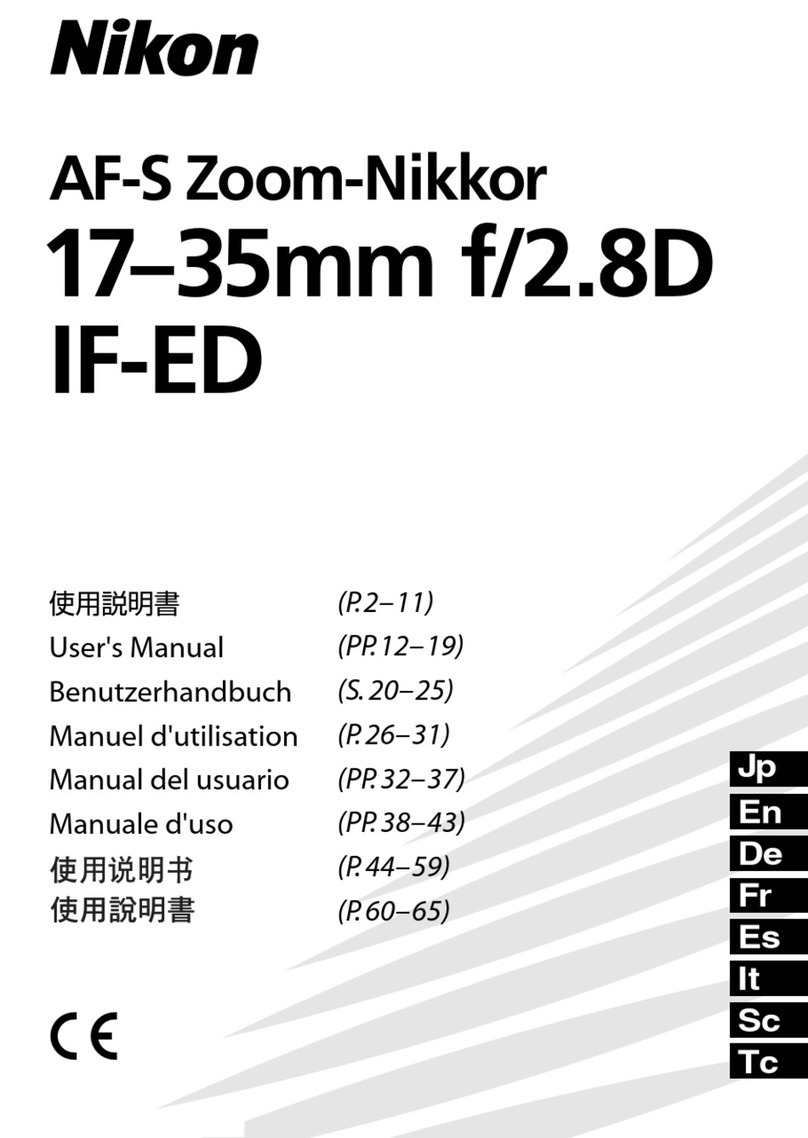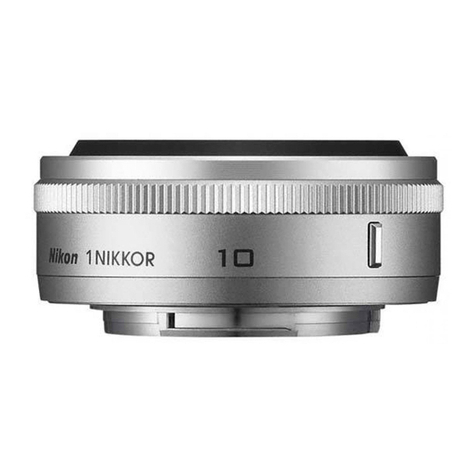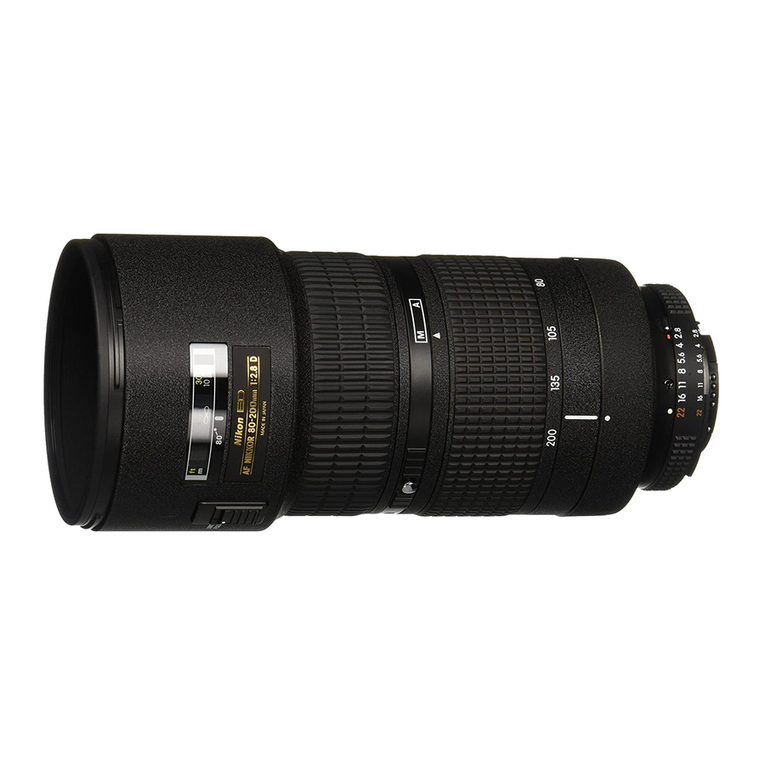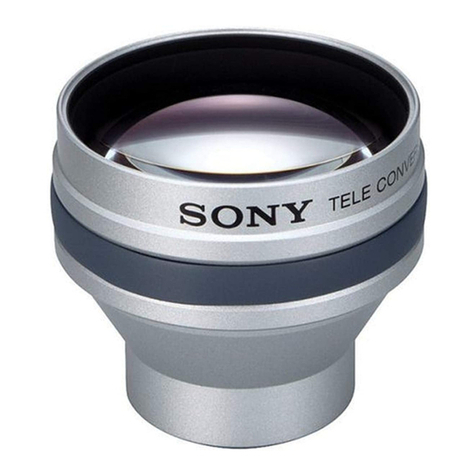
はじめに
このたびは、ニッコールレンズをお買い上げいただきありがとうございます。
ご使用の前に、この使用説明書をよくお読みのうえ、十分に理解してから正しくお使いください。
お読みになった後は、お使いになる方がいつでも見られる所に必ず保管してください。なお、カ
メラ本体の使用説明書に記載されている「安全上のご注意」も併せてお読みください。
「安全上のご注意」
●分解したり修理・改造をしないでください。
●使用しないときは、レンズにキャップをつけるか太陽光の当たらない所に保管してください。
主な特長
●ニコンのAF[オートフォーカス(F3AFを除く)]カメラとの組み合わせでオートフォーカス撮影が
できます。また、マニュアル(手動)によるピント合わせも可能です。
●スナップ撮影に手頃な撮影領域、広角28mmから中望遠105mmをカバーするコンパクト設計のレン
ズです。
●ニコン独自のIF(インナーフォーカス)により、最短撮影距離 0.5m(マクロ撮影時 約0.22m、最大撮
影倍率1/2倍)を達成するとともに、非球面レンズや良好なボケ味を表現する円形絞りの採用によ
り、コンパクトながら優れた描写性能を発揮します。
●被写体までの距離情報をカメラボディに伝達する機能を備えていますので、距離情報に対応したニ
コンカメラやスピードライト使用時、より的確な露出制御を実現する3D-マルチパターン測光や3D-
マルチBL調光を可能とします。
注記
●レンズのCPU信号接点は汚さないようにご注意ください。
●CPU信号接点を破損しますので、オート接写リングPK-11およびオートリングBR-4はご使用になれ
ません(PK-11の代わりにはPK-11Aリングを、また、オートリングBR-4の代わりにはBR-6とBR-2A
を組み合わせてご使用ください)。その他のアクセサリーとカメラボディとの組み合わせ使用に際し
ては、必ず各製品の使用説明書も併せてご参照ください。
●ニコンF3AF用DX-1ファインダーと組み合わせての使用はできません。
●テレ側のマクロ撮影(倍率1/2倍近傍)を行う際に、若干ケラレを生じる場合があります。特にフ
ィルターご使用時にはご注意ください。
ピント合わせ/ズーミング/被写界深度
ニコンAF(オートフォーカス)カメラでオートフォーカス撮影を行う場合は、ズーミングリングを回転さ
せ構図を決めてから、ピント合わせを行ってください。マニュアルフォーカス撮影を行う場合は、どの
焦点距離でもピント合わせは行えますが、長焦点になるほど像が大きく、被写界深度も浅くなりますの
でピントが合わせやすくなります。プレビュー(絞り込み)機構を持つカメラでは、撮影前に被写界深度
を確認することができます。
なお、このレンズは光学系の特性上、撮影距離が短くなるにしたがって、焦点距離が若干短くなります。
マクロ撮影(近接撮影)(図A)
このレンズは、ズーミングリングが焦点距離50〜105mmの位置において通常撮影からマクロ撮影に切り
換え可能なマクロスイッチを装備しています。マクロスイッチをMACRO側に切り換えますと、最短撮影
距離約0.22mまでのマクロ撮影が可能になります。マクロ領域は、距離目盛のオレンジ色のラインで示
されています。最大撮影倍率は焦点距離50mmで1/2.74倍、同105mmで1/2倍です。なお、マクロスイ
ッチをNORMAL側(通常撮影)に戻すときは、距離リングが無限遠(∞)〜0.5mの位置にあることを確認
してから切り換えてください。
ファインダースクリーンとの組み合わせ
ニコンF 5、F4、F3シリーズカメラボディには、多種類のファインダースクリーンがあり、レンズのタイプや
撮影条件に合わせて最適なものを選べます。このレンズに適したファインダースクリーンは、下表のとお
りです。(なお、ご使用に際しては、必ず、各カメラボディの使用説明書も併せてご参照ください。)
構図の決定やピント合わせの目的には
◎ :最適です。
:スプリットプリズム部、マイクロプリズム部および十字線部では、ピント合わせができません。周囲のマット
面でピントを合わせます。
― :各カメラに存在しないファインダースクリーンを指します。
():中央部重点測光時の補正値です。
空欄:使用不適当です。ただし、Mスクリーンの場合、撮影倍率1/1倍以上の近接撮影に用いられるため、この限り
ではありません。
* 上記以外のカメラでB、E、K2、B2、E2スクリーンをご使用の場合は、それぞれB、E、Kスクリーンの欄をご覧ください。
最小絞りロックレバー(図B)
プログラムオートやシャッター優先オートによる撮影時や絞りの設定がカメラ側で可能な場合は、レン
ズの絞りリングを最小絞りに固定しておくことができます。まずレンズの絞りリングを回し、最小絞り
(最も大きい数値)を絞り指標(緑色)に合わせます。次に、最小絞りロックレバーを絞りリングの方向に
スライドし白色指標とオレンジ指標を合わせます。これで絞りリングは最小絞りでロックされます。ロ
ックレバーを反対方向にスライドするとロックは解除されます。
開放 F 値の変化と2つの絞り指標(図C)
このレンズはズーミングにより、開放F値が最大約2/3 段変化します。
TTL露出計内蔵カメラの場合、カメラが自動補正しますので補正の必要がなく、常に適正な露出が得ら
れます。また、ニコン製スピードライトのTTLモードによるフラッシュ撮影の場合も、適正な露出が得ら
れます。ただし、絞り値の変化に伴い調光距離も変わりますので、調光距離範囲に被写体が入るように、
絞り値や撮影距離を調節して撮影してください。
外部露出計で測光したり、TTLモード以外のフラッシュ撮影を行う場合は、次のように絞り値を設定して
ください。焦点距離 28mmのときは緑色の絞り指標に、105mmのときは黄色の絞り指標に合わせます。そ
の他の焦点距離のときは、選んだ焦点距離に応じて、緑色と黄色の絞り指標の間に合わせます。緑色の
絞り指標には、クリックストップが付いています。なお、TTLモード以外のフラッシュ撮影では、緑色と黄
色の絞り指標の中間に絞り目盛を合わせることで、どの焦点距離でも、ほぼ適正な露出が得られます。
厳密な露出を得るには、図Cの開放F値変化表を参照して調節してください。
カメラ内蔵スピードライト使用時のご注意
以下のカメラの内蔵スピードライトを使用する際は、画面のケラレを防ぐため、焦点距離および撮影距
離にご注意ください。
レンズのお手入れと取り扱い上のご注意
●レンズ面の清掃は、ホコリを拭う程度にしてください。指紋がついたときは、柔らかい清潔な木綿
の布に無水アルコール(エタノール)を少量湿らせ、レンズの中心から外周へ渦巻状に、拭きムラ、
拭き残りのないように注意して拭いてください。
●シンナーやベンジンなどの有機溶剤は絶対に使用しないでください。
●レンズ表面の汚れや傷を防ぐために、L37Cフィルターを常用することをおすすめします。また、
レンズフードも役立ちます。
●レンズをケースに入れるときは、必ず、レンズキャップを前後に取り付けてください。
●レンズを長期間使用しないときは、カビやサビを防ぐために、高温多湿のところを避けて風通しの
よい場所に保管してください。また、直射日光のあたるところ、ナフタリンや樟脳のあるところも
避けてください。
●レンズを水に濡らすと、部品がサビつくなどして故障の原因となりますのでご注意ください。
●ストーブの前など、高温になるところに置かないでください。極端に温度が高くなると、外観の一
部に使用している強化プラスチックが変形することがあります。
仕様
型式: ニコンFマウントCPU内蔵Dタイプ、AFズームレンズ
焦点距離: 28mm― 105mm
最大口径比: 1:3.5― 4.5
レンズ構成: 12群16枚(非球面レンズ1枚)
画角: 74°―23°20′(IX240カメラ装着時63°〜18°40′、ニコンデジタルカメラ
D2H、D1シリーズ、D100装着時53°〜15°20′)
焦点距離目盛: 28、35、50、70、85、105mm
撮影距離情報: カメラボディへの撮影距離情報出力可能
ズーミング: ズーミングリングによる回転式
ピント合わせ: 距離リングによる回転式
撮影距離目盛: ∞〜0.5m、2ft(併記)、マクロ領域は0.5m〜約0.22m
最大撮影倍率: 1/2.74倍(50mm)、1/2倍(105mm)
マクロ機能: マクロスイッチによる切り換え式
赤外指標: 焦点距離28mm時のみ
絞り目盛: 3.5、5.6、8、11、16、22(f/4は、クリックストップの み )、最小絞りでロック可能
(ファインダー内直読み用目盛併記)
絞り方式: 自動絞り
測光方式: CPU・AI方式のカメラボディでは開放測光、従来方式のカメラボディで は
絞り込み測光
アタッチメントサイズ: 62mm(P=0.75mm)
大きさ: 約73mm(最大径)×約81.5mm(長さ:バヨネット基準面からレンズ先端 まで )、
全長約92mm
質量(重さ): 約455g
AF Zoom-Nikkor
28-105mm
f/3.5-4.5D IF
NIKON CORPORATION
FUJI BLDG., 2-3 MARUNOUCHI 3-CHOME, CHIYODA-KU,
TOKYO 100-8331, JAPAN
Printed in Japan TT3L03600801 (K369) 80 8MNJA766-07
使用説明書の内容が破損などによって判読できなくなったときは、当社サービス機関にて新しい使用説明書をお求めください(有料)。
No reproduction in any form of this manual, in
whole or in part (except for brief quotation in
critical articles or reviews), may be made without
written authorization from NIKON CORPORATION.
使用説明書
Instruction Manual
Bedienungsanleitung
Manuel d’utilisation
Manual de instrucciones
Manuale di istruzioni
日本語 English Deutsch Français
スクリーン
カメラ
F5+DP-30 ◎
◎
◎ ◎
◎
(+0.5)
◎
(+0.5)
◎
― ◎ ―
― ◎ ―
― ◎ ― ◎
― ◎ ―
― ―
― ―
― ― ◎ ― ◎ ― ◎
―
―
― ― ◎ ― ◎ ―
―
―
―
◎ ◎ ◎
EC-B
EC-E G1/G2
G3/G4 H1/H2
H3/H4
ABCDEF JK LMPR/S/T U
F4+DP-20
F4+DA-20
F3
F5+DA-30
1絞り指標/着脱指標(緑色)*
Aperture index/Mounting index (green)*
Blendenindex/Objektivindex (grün)*
Index d'ouverture/index de
montage (vert)*
Indice de aberturas/índice de
monturas (verde)*
Indice delle aperture/Indice di
montaggio (verde)*
2絞りリング
Aperture ring
Blendenring
Bague des ouvertures
Anillo de aberturas
Anello di apertura
3露出計連動ガイド
Meter coupling ridge
Steuerkurve
Index de couplage du posemètre
Protuberancia de acoplamiento al
exposímetro
Indice di accoppiamento
dell'esposimetro
4CPU信号接点
CPU contacts
CPU-Kontakte
Contacts CPU
Contactos CPU
Contatti CPU
5開放F値連動ガイド
Aperture indexing post
Anschlag für Blendenkupplung
Douille d'indexation d'ouverture
Poste de índice de apertura
Perno per misurazione dell'apertura
6ファインダー内直読用絞り目盛
Aperture-direct-readout scale
Skala für Blendendirekteinspiegelung
Echelle de lecture directe de l'ouverture
Escala de lectura directa de apertura
Scala di lettura diretta delle aperture
7絞り目盛
Aperture scale
Blendenskala
Echelle des ouvertures
Escala de apertura
Scala delle aperture
8
最小絞り信号ガイド(EE連動ガイド)
Minimum aperture signal post
(EE servo coupling post)
Signalstift für kleinste Blende
(Kupplungsstift für automatische
Blendensteuerung)
Levier de signal d'ouverture minimale
(levier de servo couplage EE)
Borne de señal de abertura mínima
(Borne de acoplador EE)
Attacco di segnale di apertura minima
(attacco per accoppiamento EE servo)
9最小絞りロックレバー
Minimum aperture lock lever
Verriegelung für kleinste Blende
Levier de verrouillage d'ouverture
minimale
Palanca de fijación de apertura mínima
Leva di blocco di apertura minima
!ズーミングリング
Zoom ring
Zoomring
Bague de zoom
Anillo de zoom
Anello dello zoom
"マクロスイッチ
Macro switch
Makroschalter
Commande macro
Interruptor macro
Interruttore macro
#フード取り付け指標(2ヶ所)
Lens hood mounting indexes (2)
Montageindizes (2) für Gegenlichtblende
Index de montage de pare-soleil (2)
Indices de montaje de visera del
objetivo (2)
Indici di montaggio del paraluce (2)
$赤外指標(焦点距離28mm時)
Infrared compensation index (at 28mm)
Infrarot-Kompensationsindex
(bei 28mm)
Repère de mise au point en infrarouge
(à 28mm)
Indicador de enfoque infrarrojo
(a 28mm)
Indice di compensazione per infrarossi
(a 28mm)
%距離目盛/焦点距離目盛基準線
Distance/focal length index line
Entfernungs/Brennweiten-Indexlinie
Ligne de repère des distances/des
distances focales
Línea indicadora de distancia/distancia
focal
Contrassegno distanza/lunghezza focale
&距離目盛
Shooting distance scale
Aufnahmedistanzskala
Echelle des distances
Escala de distancias de la toma
Scala delle distanze di ripresa
(焦点距離目盛
Focal length scale
Brennweitenskala
Echelle des distances focales
Escala de distancias focales
Scala della lunghezza focale
)
マクロ領域ライン(オレンジ色)
Macro shooting range (orange line)
Makroaufnahmebereich (orangerote
Linie)
Plage de prise de vue macro (ligne
orange)
Gama de tomas macro (línea naranja)
Gamma di ripresa in macro (linea
arancione)
~距離リング
Focus ring
Entfernungseinstellring
Bague de mise au point
Anillo de enfoque
Anello di messa a fuoco
付属アクセサリー
62mmスプリング式前キャップ
裏ぶたLF-1
図B 最小絞りロックレバー
Fig. B Minimum aperture lock lever
Abb. B Verriegelung der kleinsten Blende
Fig. B Verrouillage d'ouverture minimale
Fig. B Palanca de bloqueo de apertura mínima
Fig. B Leva di blocco al diaframma minimo
図A マクロスイッチ
Fig. A Macro switch
Abb. A Makroschalter
Fig. A Commande macro
Fig. A Interruptor macro
Fig. A Interruttore macro
J
E
G
F
S
IT
Ck
Ch
* レンズ装着指標として、レンズ鏡筒のバヨネットの黒色の小ねじもご利用ください。
*You can also use the black screw on the lens bayonet as a mounting index.
*Die schwarze Schraube am Objektivbajonett stellt darüber hinaus auch eine Montagehilfe dar.
*Vous pouvez aussi utiliser une vis noire sur la baïonnette comme index de montage.
*Usted puede también utilizar el tornillo negro en las lentes bayoneta, como indicador de montaje.
*Potete anche usare una vite nera sulla baionetta come indice di montaggio.
カメラ 使用可能な焦点距離および撮影距離 使用可能な焦点距離および撮影距離
プロネアS
焦点距離35mm、撮影距離1.5m以上で使用可能
F50D
焦点距離35mm以上で使用可能
F-601
焦点距離28mm、撮影距離1m以上で使用可能
カメラ
全ての焦点距離、撮影距離1.8m以上で使用可能
ニコン
Standard accessories
62mm snap-on front lens cap
Rear lens cap LF-1
Serienmäßiges Zubehör
Vorderer Objektivdeckel 62 mm
Objektivrückdeckel LF-1
Accessoires fournis
Bouchon avant d'objectif diamètre 62 mm
Bouchon arrière LF-1
Accesorios estándar
Tapa a presión de 62 mm para el objetivo delantero
Tapa LF-1 para el objetivo trasero
Accessori in dotazione
Coperchietto anteriore ø62mm
Tappo posteriore LF-1
You are now the proud owner of the AF Zoom-Nikkor 28–105mm f/3.5–4.5D IF, a lens that will
provide you with years of exciting picture-taking opportunities. Before using this lens, please read
these instructions and the notes on safety operations in your camera’s instruction manual. Also, keep
this manual handy for future reference.
Major features
•Autofocus operation is possible with Nikon autofocus cameras (except the F3AF); manual focus possible with
all Nikon SLRs.
•Aconvenient range of focal lengths from 28mm wideangle to 105 mm medium telephoto.
•Thanks to its internal focusing (IF) system, there is no change in the overall length of the lens from infinity to its
closest focusing distance of 0.5m (1.6 ft.). In the macro range, this range extends to approx. 0.22m (0.7 ft.) with
a maximum reproduction ratio of 1:2. In addition, outstanding image quality is provided through the use of an
aspherical lens element, while an eight-bladed diaphragm creates a naturally blurred background when using
either wide apertures and/or telephoto zoom settings.
•For more accurate exposure control, subject distance information is transmitted from the lens to the camera
body, providing 3D Matrix Metering and 3D Multi-Sensor Balanced Fill Flash with appropriate Nikon cameras
and Speedlights.
Important!
•Be careful not to soil or damage the CPU contacts.
•Do not attach the following accessories to this lens, as they might damage the CPU contacts: Auto Extension
Ring PK-11 (use PK-11A) and Auto Ring BR-4 (use BR-6 with BR-2A). Other accessories may not be suitable
when this lens is used with certain camera bodies. For details, refer to instruction manual for each product.
•This lens is not compatible with a Nikon F3AF camera when the AF Finder DX-1 is attached.
•At a telephoto setting, slight vignetting may occur when shooting subjects with the macro switch set to MACRO
(at a reproduction ratio of approx. 1:2), particularly when using a filter.
Focusing, zooming and depth of field
With Nikon autofocus cameras (except the F3AF), first turn the zoom ring until the desired composition is framed
in the viewfinder before performing autofocus. For manual focus, focusing is possible at any focal length, but is
easier at longer focal lengths, because the image is larger and depth of field is shallower. If your camera has a
depth of field preview (stop-down) button or lever, depth of field can be observed while looking through the
camera viewfinder.
Due to the optical characteristics of this lens, as the lens is focused closer, the focal length decreases slightly.
Macro focusing (Fig. A)
Normal focus extends from infinity (∞) to 0.5m (1.6 ft.). When the macro switch is set to MACRO, the lens will
focus down to approx. 0.22m (0.7 ft.). Macro focusing is possible within the 50–105mm range. The macro range
is indicated by an orange line on the lens barrel. A maximum reproduction ratio of approximately 1:2.74 is
obtained at the 50mm setting, while a reproduction ratio of 1:2 is possible at 105mm.
When moving the macro switch back to NORMAL, make sure the focus ring is set between infinity (∞) and 0.5m.
Recommended focusing screens
Various interchangeable focusing screens are available for certain Nikon SLR cameras to suit any type of lens or
picture-taking situation. Those recommended for use with this lens are listed in the table.
◎:Excellent focusing
:Acceptable focusing
Split-image rangefinder, microprism or cross-hair area is dim; focus on the surrounding matte area.
―:Not available.
():Indicates degree of exposure compensation needed (Center-Weighted metering only).
Blank box means not applicable. Since type M screen can be used for both macrophotography at a 1:1 magnification ratio and for
photomicrography, it has different applications than other screens.
When using the B, E, K2, B2 and E2 focusing screens in cameras other than those listed above, refer to the columns for the B, E
and K screens.
Minimum aperture lock (Fig. B)
For program or shutter-priority auto exposure shooting, use the minimum aperture lock lever to lock the lens
aperture at f/22.
1. Set the lens to its minimum aperture (f/22) by aligning it with the aperture index (green).
2. Slide the lock lever toward the aperture ring, so the white dot on the lever aligns with the orange dot.
To release the lock, slide the lever in the opposite direction.
Variable aperture/two aperture indexes (Fig. C)
Zooming the lens from 28mm to 105mm decreases the maximum aperture approx. 2/3 of an f/stop. For cameras
with TTL metering, there is no need to adjust the aperture. Likewise, for TTL auto flash photography with Nikon
Speedlights, no adjustment is required. However, when the flash-to-subject distance approaches either the near or
far limit of the automatic shooting range, the aperture may need to be adjusted slightly.
When using a separate exposure meter or taking photographs in the non-TTL flash mode, select the appropriate
aperture index according to the focal length setting in the following way: The green aperture index is used for the
28mm focal length setting and the yellow one for the 105mm setting. Click stops are provided at the green aperture
index for each aperture setting. For zoom settings between 28 and 105mm, align the aperture ring between the two
indexes to obtain the best overall exposure. To determine the correct aperture, refer to Fig. C–Relationship between
focal length and maximum aperture.
Taking flash pictures with cameras having built-in flash
Check the focal length and shooting distance before taking flash pictures to prevent vignetting from occurring.
*Sold exclusively in the U.S.A.
Lens Care
•Do not disassemble, repair or modify the lens yourself.
•Clean the lens surface with a blower brush. To remove dirt and smudges, use a soft, clean cotton cloth or lens
tissue moistened with ethanol (alcohol) or lens cleaner. Wipe in a circular motion from center to outer edge,
taking care not to leave traces or touch other parts.
•Never use thinner or benzene to clean the lens as this might damage the lens, result in a fire, or cause health
problems.
•To protect the front lens element, an NC filter is recommended at all times. A lens hood also helps protect the
front of the lens.
•When storing the lens in the lens case, attach both front and rear caps.
•When the lens will not be used for a long time, store it in a cool, dry place to prevent mold. Also store the lens
away from direct sunlight or chemicals such as camphor or naphthalene.
•Do not get water on the lens or drop it in water as this will cause it to rust and malfunction.
•Reinforced plastic is used for some parts of the lens. To avoid damage, never leave the lens in an excessively
hot place.
Specifications
Type of lens: D-type AF Zoom-Nikkor lens having built-in CPU and Nikon bayonet mount
Focal length: 28mm–105mm
Maximum aperture: f/3.5–4.5
Lens construction: 16 elements in 12 groups (one aspherical lens)
Picture angle: 74˚–23˚20’ (63˚–18˚40’ with IX240 system cameras; 53˚–15˚20’ with the
Nikon digital SLR cameras D2H, D1-Series and D100)
Focal length scale: 28, 35, 50, 70, 85, 105mm
Distance information: Output to camera body
Zoom control: Manually via separate zoom ring
Focusing: Autofocus with Nikon autofocus cameras (except F3AF); manually via separate
focus ring
Shooting distance scale: Graduated in meters and feet from 0.5m (2 ft.) to infinity (∞); macro focusing
down to approx. 0.22m (0.7 ft.) possible with macro switch set to MACRO
Max. reproduction ratio: 1:2.74 (at 50mm), 1:2 (at 105mm)
Macro focusing: Selected with Macro switch
Infrared compensation index: Provided for 28mm setting only
Aperture scale: f/3.5—f/22 on both standard and aperture-direct-readout scales; at f/4 there is
a click stop, but no mark.
Minimum aperture lock: Provided
Diaphragm: Fully automatic
Exposure measurement: Via full-aperture method with AI camera or cameras with CPU interface system;
via stop-down method with other cameras
Attachment size: 62mm (P=0.75mm)
Dimensions: Approx. 73mm dia. x 81.5mm extension from the camera’s lens mounting
flange; overall length is approx. 92mm
Weight: Approx. 455g (1.0 lb.)
Screen
Camera
F5+DP-30 ◎
◎
◎ ◎
◎
(+0.5)
◎
(+0.5)
◎
― ◎ ―
― ◎ ―
― ◎ ― ◎
― ◎ ―
― ―
― ―
― ― ◎ ― ◎ ― ◎
―
―
― ― ◎ ― ◎ ―
―
―
―
◎ ◎ ◎
EC-B G1/G2
G3/G4 H1/H2
H3/H4
ABCDEF JK LMPR/S/T U
F4+DP-20
F4+DA-20
F3
F5+DA-30
EC-E
Camera Usable focal length/
shooting distance
Pronea S 35mm / 1.5m or more F50-Series/N50* 35mm or longer
F-601/N6006* 28mm/1m or more
Camera Usable focal length/
shooting distance
F65-Series/N65-Series
*Any focal length/1.8m or more
Optional accessories
・62mm screw-in filters ・Teleconverters TC-201, TC-14A ・Bayonet hood HB-18
・Hard lens case CL-49 ・Flexible lens pouch CL-S1 — S4
Wir danken Ihnen für das Vertrauen, das Sie Nikon mit dem Kauf des AF Zoom-Nikkor 28–105 mm
f/3.5–4.5D IF bewiesen haben, und wir hoffen, daß Sie viele Jahre ungetrübte Freude an Ihrem neuen
Objektiv haben werden. Bitte lesen Sie diese Gebrauchsanweisung sorgfältig durch sowie die
entsprechenden Abschnitte in der Bedienungsanleitung Ihrer Kamera. Bewahren Sie diese Anleitung
für späteres Nachschlagen griffbereit auf.
Hauptmerkmale
•Autofokusbetrieb mit entsprechend ausgerüsteten Nikon-Autofokuskameras (außer F3AF); manuelle
Schärfeneinstellung mit allen Nikon-Spiegelreflexkameras.
•Großer Zoombereich von 28 mm Weitwinkel bis 105mm Tele.
•Dank des Innenfokussiersystems (IF) keinerlei Änderung der Objektivlänge von unendlich bis zur kürzesten
Aufnahmedistanz von 0,5 m. In der Makroeinstellung sind Aufnahmedistanzen bis 0,22 m bei einem
größtmöglichen Abbildungsverhältnis von 1:2 möglich. Hervorragende Bildqualität dank einer asphärische
Linse. Ein achtblättriger Objektivverschluß sorgt für natürlich unscharfen Hintergrund sowohl bei Weitwinkel-
als auch Teleeinstellungen.
•Für noch genauere Belichtungsregelung wird die Distanz zum Aufnahmeobjekt vom Objektiv an die Kamera
übermittelt, so daß 3D-Matrix-Messung sowie 3D-Multi-Sensor-Aufhellblitzen mit entsprechend geeigneten
Nikon-Kameras und Nikon-Speedlights möglich ist.
Achtung!
•Halten Sie die CPU-Kontakte peinlich sauber, und schützen Sie sie vor Beschädigung!
•Folgendes Zubehör darf nicht an das Objektiv angesetzt werden, da es die CPU-Kontakte beschädigen könnte:
Automatik-Zwischenring PK-11 (stattdessen PK-11A verwenden) und Automatikring BR-4 (stattdessen BR-6 mit
BR-2A verwenden). Anderes Zubehör kann bei Verwendung des Objektivs mit gewissen Kameramodellen
ungeeignet sein. Einzelheiten entnehmen Sie bitte der jeweiligen Bedienungsanleitung.
•Das Objektiv ist nicht zur Verwendung mit der Nikon F3AF mit angesetztem AF-Sucher DX-1 geeignet.
•In der Telestellung kann es zu leichter Vignettierung kommen, wenn der Makroschalter auf MACRO (mit
Abbildungsverhältnis von ca. 1:2) steht, insbesondere wenn ein Filter vorgesetzt ist.
Fokussieren, Zoomen und Tiefenschärfe
Mit Nikon-Autofokuskameras (außer F3AF) wählen Sie zunächst durch Drehen des Zoomrings den gewünschten
Bildausschnitt, bevor Sie die automatisch Schärfeneinstellung aktivieren. Bei manueller Schärfeneinstellung spielt
die Brennweiteneinstellung keine Rolle, gestaltet sich bei langen Brennweiten jedoch einfacher, weil dann das Bild
größer und die Schärfentiefe geringer ist. Wenn Ihre Kamera über einen Schärfentiefenknopf oder –hebel verfügt,
können Sie die Schärfentiefe im Sucher betrachten.
Aufgrund der optischen Eigenschaften dieses Objektivs ergibt sich bei Nahfokussierung eine geringfügige
Verringerung der Brennweite.
Makroeinstellung (Abb. A)
Der normale Schärfenbereich geht von unendlich (∞) bis 0,5 m. Bei Einstellen des Makroschalters auf MACRO
sind Aufnahmedistanzen bis 0,22 m möglich. Das Fokussieren bei Makroeinstellung ist innerhalb eines
Brennweitenbereichs von 50–105 mm möglich. Der Makrobereich wird anhand einer orangeroten Linie auf dem
Objektivtubus angezeigt. Das größtmögliche Abbildungsverhältnis ergibt sich bei 50 mm Brennweite und beträgt
dann 1:2,74; bei 105 mm ist es 1:2.
Bevor Sie den Makroschalter wieder auf NORMAL zurückstellen, sorgen Sie dafür, daß der Fokussierring zwischen
unendlich (∞) bis 0,5 m eingestellt ist.
Empfohlene Einstellscheiben
Für bestimmte Nikon-Kameras stehen verschiedene auswechselbare Einstellscheiben zur Verfügung, um jeder
Aufnahmesituation gerecht zu werden. Die zur Verwendung mit diesem Objektiv empfohlenen sind nachstehend
aufgelistet:
◎:Hervorragende Scharfeinstellung
:Brauchbare Scharfeinstellung
Schnittbildindikator, Mikroprismenfeld oder Fadenkreuzbereich dunkeln ab. Fokussierung auf Einstellscheiben-Umfeld.
―:Nicht möglich
():Zeigt den Betrag zusätzlich erforderlicher Belichtungskorrektur (nur bei mittenbetonter Messung).
Ein Leerfeld bedeutert: unbrauchbar. Da die Einstellscheibe M sowohl für Maktrofotografie bis zum Abbildungsmaßstab 1:1 als
auch Mikrofotografie eingesetzt werden kann, unterscheidet sich ihr Anwendungsbereich von dem anderer Einstellscheiben.
Bei Verwendung der Scheiben B, E, K2, B2 bzw. E2 in anderen als den obengenannten Kameras gelten die Spalten für die
Scheiben B, E und K.
Verriegelung auf kleinster Blende (Abb. B)
Für Programm- und Blendenautomatik muß der Blendenring auf kleinster Öffnung (22) verriegelt werden.
1. Drehen Sie den Blendenring, bis die Blendenzahl 22 dem Blendenindex (grün) gegenübersteht.
2. Schieben Sie den Riegel in Richtung auf den Blendenring, so daß der Riegel auf den orangefarbenen Punkt
ausgerichtet ist.
Zur Entriegelung schieben Sie den Riegel in die entgegengesetzte Richtung.
Gleitende Lichtstärke/zwei Blendenindizes (Abb. C)
Beim Durchfahren des Brennweitenbereichs von 28 mm auf 105 mm verringert sich die Anfangsöffnung um ca.
2/3 Blende. Kameras mit Innenmessung gleichen dies automatisch aus. Auch bei TTL-Blitzautomatik mit einem
Nikon Blitzgerät ist keine Korrektur erforderlich. Eine geringe Korrektur kann jedoch an der Nah- bzw. Ferngrenze
der Blitzreichweite erforderlich werden.
Bei Verwendung eines Handbelichtungsmessers oder bei Aufnahmen im Computer-Blitzbetrieb wählen Sie den
Blendenindex nach der jeweils eingestellten Brennweite: Der grüne Blendenindex gilt für 28 mm, der gelbe für
105 mm. Am grünen Blendenindex ist der Blendenring bei jeder Blendenstufe mit Rastungen versehen. Für
Brennweiten zwischen den beiden Extremen verwenden Sie eine Mittelstellung zwischen beiden Blendenindizes.
Zur Bestimmung der korrekten Blende siehe Abb. C–Zusammenhang zwischen Brennweite und größter Öffnung.
Blitzaufnahmen mit Kameras mit eingebautem Blitz
Überprüfen Sie vor der Blitzaufnahme Brennweite und Aufnahmeentfernung, um Vignettierung zu vermeiden.
Pflege des Objektivs
•Versuchen Sie unter keinen Umständen, das Objektiv zu zerlegen, zu reparieren oder zu modifizieren.
•Säubern Sie Glasflächen mit einem Blasepinsel. Staub und Flecken entfernen Sie mit einem sauberen, weichen
Baumwolltuch oder Optik-Reinigungspapier, das Sie mit éthanol (Alkohol) oder Optik-Reinigungsflüssigkeit
anfeuchten. Wischen Sie in kreisförmigen Bewegungen von der Mitte nach außen, ohne daß Wischspuren
zurückbleiben.
•Verwenden Sie keinesfalls Verdünnung oder Benzin zur Reinigung, da dieses zu Beschädigungen führen,
Gesundheitsschäden verursachen oder ein Feuer auslösen könnte.
•Zum Schutz der Frontlinse empfiehlt es sich, stets ein NC-Filter aufgesetzt zu lassen. Die Gegenlichtblende
wirkt als zusätzlicher Frontlinsenschutz.
•Bei Aufbewahrung des Objektivs in seinem Köcher sollten beide Objektivdeckel aufgesetzt sein.
•Bei längerer Nichtbenutzung sollte das Objektiv an einem kühlen, trockenen Ort aufbewahrt werden. Halten Sie
das Objektiv von direkter Sonneneinstrahlung oder Chemikalien wie Kampfer oder Naphthalin fern.
•Halten Sie das Objektiv von Wasser fern, das zur Korrosion und zu Betriebsstörungen führen kann.
•Einige Teile des Objektivs bestehen aus verstärktem Kunststoff. Lassen Sie das Objektiv deshalb nie an
übermäßig heißen Orten zurück!
Technische Daten
Objektivtyp: AF Zoom-Nikkor mit D-Charakteristik, eingebauter CPU und Nikon-Bajonett
Brennweite: 28–105 mm
Maximale Blendenöffnung: f/3,5–4,5
Optischer Aufbau: 16 Linsen in 12 Gruppen (asphärische Linse)
Bildwinkel: 74˚–23˚20’ (63˚ bis 18˚40’ bei Kameras des Advanced Photo System;
53˚–15˚20’ mit Nikons digitalen Spiegelreflexkameras D2H, Serie D1
und D100)
Brennweitenskala: 28, 35, 50, 70, 85, 105mm
Entfernungsdaten: Werden an Kameras übertragen
Zoomen: Manuell über separaten Zoomring
Schärfeneinstellung: Autofokus mit Nikon-Autofokuskameras (außer F3AF); manuell über
Fokussierring
Entfernungsskala: Unterteilt in Meter und Fuß, und zwar von 0,5 m bis unendlich (∞);
Makroschalter in Stellung MACRO bis ca. 0,22 m
Max. Abbildungsverhältnis: 1:2,74 (bei 50 mm), 1:2 (bei 105 mm)
Makrofokussierung: Bei Umschalten des Makroschalters
Infrarotkompensationsindex: Nur für 28-mm-Einstellung vorgesehen
Blendenskala: f/3,5 –f/22, sowohl auf der Standardskala als auch der Skala für
Blendendirekteinspiegelung; bei Blende 4 lediglich Einrastung
Verriegelung für kleinste Blende: Vorhanden
Blendenart: Vollautomatisch
Belichtungsmessung: Offenblendenmessung bei Kameras mit AI-Blendenkupplung oder CPU-
Interface-System; Arbeitsblendenmessung bei allen anderen Kameras
Befestigungsgröße: 62 mm (P = 0,75mm)
Abmessungen: ca. 73 mm Durchm. x 81,5 mm Länge bis Flansch; Gesamtlänge ca. 92mm
Gewicht: ca. 455 g
Einstellscheibe
Kamera
F5+DP-30 ◎
◎
◎ ◎
◎
(+0.5)
◎
(+0.5)
◎
― ◎ ―
― ◎ ―
― ◎ ― ◎
― ◎ ―
― ―
― ―
― ― ◎ ― ◎ ― ◎
―
―
― ― ◎ ― ◎ ―
―
―
―
◎ ◎ ◎
EC-B G1/G2
G3/G4 H1/H2
H3/H4
ABCDEF JK LMPR/S/T U
F4+DP-20
F4+DA-20
F3
F5+DA-30
EC-E
Kamera Verwendbare Brennweite/
Aufnahmedistanz
Pronea S 35 mm/1,5 m oder mehr F50-Serie 35 mm oder länger
F-601 28 mm/1 m oder mehr
Kamera Verwendbare Brennweite/
Aufnahmedistanz
F65-Serie Jeder Brennweite/1,8 m oder mehr
Sonderzubehör
・Einschraubfilter 62mmø ・Telekonverter TC-201, TC-14A ・Bajonett-Gegenlichtblende HB-18
・Fester Objektivköcher CL-49 ・Objektivbeutel CL-S1 — S4
Vous êtes maintenant l'heureux propriétaire d'un AF Zoom-Nikkor 28–105mm f/3,5–4,5D IF, un
objectif qui vous permettra de prendre des photos remarquables pendant des années. Avant d'utiliser
cet objectif, veuillez lire ce mode d'emploi et les remarques sur la sécurité dans le mode d'emploi de
votre boîtier. Conservez ce manuel à portée de la main pour toute référence ultérieure.
Principales caractéristiques
•L'autofocus est possible avec un boîtier autofocus Nikon (sauf F3AF), la mise au point manuelle avec tous les
appareils reflex Nikon.
•Une gamme pratique de focales allant du 28 mm grand-angle au 105 mm téléobjectif moyen.
•Grâce à son système de mise au point interne (IF), la longueur totale de l'objectif ne change pas de l'infini à la
focale la plus rapprochée de 0,5 m. En macro, la plage va jusqu'à environ 0,22 m à un taux de reproduction de
1:2. De plus, l'élément asphérique procure une qualité d'image remarquable, alors que le diaphragme à 8 lames
crée un fond naturel flou à l'emploi des réglages de grande ouverture et/ou du zoom téléobjectif.
•Pour assurer un contrôle d'exposition plus précis, l'information de distance au sujet est transmise de l'objectif
au boîtier, ce qui permet la mesure matricielle 3D et le dosage auto flash/ambiance par multi-capteur 3D avec
les boîtiers et flashes Nikon convenables.
Important
•Veiller à ne pas salir ni endommager les contacts CPU.
•Ne pas essayer de monter les accessoires suivants, car ils risquent d’abimer les contacts: Bague d’auto-rallonge
PK-11 (utilisez PK-11A), et Bague auto BR-4 (utilisez la bague BR-6 avec BR-2A).
D’autres accessoires peuvent ne pas convenir lorsque l’objectif est utilisé avec certains boîtiers. Se référer aux
manuels d’instruction.
•Cet objectif n’est pas compatible avec le boîtier F3AF équipé du viseur DX-1.
•Au réglage téléobjectif, un léger vignettage peut survenir à la prise de sujets avec la commande de macro réglée
à MACRO (à un taux de reproduction d’environ 1:2), en particulier si vous utilisez un filtre.
Mise au point, cadrage au zoom et profondeur de champ
Avec les boîtiers autofocus Nikon (sauf le F3AF), tournez d'abord la bague de zoom jusqu'au cadrage de la
composition souhaitée dans le viseur avant d'effectuer l'autofocus. En manuel, la mise au point est possible à
toute focale, mais plus facile à des focales plus longues parce que l'image est plus grande et la profondeur de
champ réduite. Si votre boîtier est doté d'un bouton ou levier de prévisionnage de la profondeur de champ
(fermeture), vous pouvez contrôler la profondeur de champ en regardant dans le viseur de l'appareil.
A cause des caractéristiques optiques de cet objectif, la focale diminue légèrement en faisant une mise au point
plus rapprochée.
Mise au point macro (Fig. A)
La mise au point normale va de l'infini (∞) à 0,5 m. Quand la commande macro est réglée à MACRO, l'objectif
fera la mise au point jusqu'à environ 0,22 m. La mise au point macro est possible sur la plage de 50–105 mm. La
plage macro est indiquée par une ligne orange sur le barillet de l'objectif. Un taux de reproduction maximum
d'environ 1:2,74 est obtenu au réglage 50 mm, alors que le taux de reproduction de 1:2 est possible à 105 mm.
En ramenant la commande macro à NORMAL, vérifiez que la bague de macro est réglée entre l'infini (∞) et 0,5m.
Ecrans de mise au point recommandés
Divers écrans de mise au point sont disponibles pour certains appareils Nikon SLR qui s’adaptent à toutes les
conditions de prise de vues. Les écrans recommandés avec cet objectif sont listés ci-dessons:
◎:Mise au point excellente
:Mise au point passable
Image coupée au télémètre, zone microprisme ou en toile d’araignée terne. Mise au point autour de la zone tressée.
―:Non disponible
():Indique la compensation de l’exposition additionnelle requise (mesure centrale pondérée seulement).
Un blanc indique aucune application. Du fait que le verre M peut être utilisé pour la macrophotographie à un rapport
d’agradissement 1:1 et pour la photomicrographie, il a des applications diffèrentes de celles des autres verres.
Lors de l’utilisation de verres B, E, K2, B2 ou E2 dans des appareils autres que ceux indiqués ci-dessus, se reporter aux colonnes
sur les verres B, E et K.
Blocage d’ouverture minimale (Fig. B)
En mode Programme ou Auto priorité vitesse, réglez puis verrouillez le diaphragme sur l’ouverture minimale (f/22).
1. Réglez le diaphragme sur l’ouverture mini (f/22) en alignant sur le repère d'ouverture (vert).
2. Glissez le curseur de blocage vers la bague de diaphragme de façon à ce que le point blanc du curseur soit
aligné avec le point orange.
Pour débloquer, glissez le curseur dans l’autre direction.
Ouverture variable / double repère de réglage. (Fig. C)
La variation de la focale de 28 mm à 105 mm implique une réduction de l’ouverture maximale de 2/3 de valeur
environ. Aucune compensation n’est nécessaire pour un appareil muni de système TTL. De même, la
photographie au flash avec des flashes TTL NIKON ne requiert aucune correction.
Néanmoins, lorsque la distance de prise de vue est proche des limites inférieure ou supérieure de l’automatisme,
une légère correction est conseillée.
Avec une cellule indépendante ou en photographie au flash non TTL, utilisez le repère approprié à la focale de la
façon suivante: Le repère vert sert pour la focale de 28 mm, et le repère jaune pour la focale de 105 mm. Un
crantage est prévu sur le repère vert. Pour les focales intermédiaires, choisir une position de réglage entre les
deux index. Pour déterminer l'ouverture correcte, ajustez l'ouverture en vous référant à la Fig. C–Relation entre la
distance focale et l'ouverture maximale.
Prise de vues au flash avec un appareil à flash intégré
Vérifiez la distance focale et la distance de prise de vue avant de prendre des photos au flash pour éviter le
vignettage.
Soin de l’objectif
•Ne démontez pas, ne réparez pas et ne modifiez pas l'objectif vous-même.
•Nettoyer la surface de l’objectif avec un pinceau soufflant. Pour enlever les poussières ou les traces, utiliser
de préférence un tissu de coton doux, ou un tissu optique, légèrement humidifié avec de l’alcool éthylique
(éthanol). Essuyer en mouvement circulaire partant du centre.
•Ne jamais employer de solvant ou de benzènes qui pourrait endommager l’objectif, prendre feu ou nuire à
la santé.
•Il est recommandé d’utiliser un filtre NC en permanence, pour protéger la lentille frontale. Un paresoleil assure
également une bonne protection contre les chocs.
•Lors du rangement de l’objectif dans son étui, penser à remettre en place les bouchons avant et arrière.
•En cas d’inutilisation pour une longue période, entreposer le matériel dans un endroit frais, sec et aéré pour
éviter les moisissures. Tenir le matériel éloigné des sources de lumière, et des produits chimiques (camphre,
naphtaline, etc.).
•Eviter les projections d’eau ainsi que l’immersion, qui peut provoquer la rouille et des dommages irréparables.
•Divers matériaux de synthèse sont utilisés dans la fabrication. Pour éviter tout problème, ne pas soumettre
l’objectif à de fortes chaleurs.
Caractéristiques
Type d’objectif: Zoom-Nikkor AF, Type D avec processeur. Baïonnette Nikon
Focale: 28–105 mm
Ouverture maximale: f/3,5–4,5
Construction optique: 16 éléments en 12 groupes (un élément asphérique)
Champ angulaire: 74˚–23˚20' (63˚ à 18˚40’ avec appareil IX240; 53˚–15˚20’ avec les appareils
numériques Nikon SLR D2H, Série D1 et D100)
Focales: 28, 35, 50, 70, 85, 105mm
Informations sur la distance: A l'appareil
Zooming: Manuel avec bague de zoom séparée
Mise au point: Autofocus avec un boîtier autofocus Nikon (sauf F3AF); manuelle via une
bague de mise au point séparée
Echelle des distances: Graduée en mètres et pieds de 0,5 m (2 ft.) à l'infini (∞); mise au point macro
jusqu'à env. 0,22 m possible avec la commande macro réglée à MACRO
Rapport de reproduction max: 1:2,74 (à 50 mm), 1:2 (à 105 mm)
Mise au point macro: Sélectionnée avec la commande macro
Index de correction infrarouge: Fourni pour le réglage 28 mm seulement
Echelle des ouvertures: f/3.5 – f/22 pour les échelles standard et de lecture directe de l'ouverture;
à f/4 le déclic est fourni, mais sans repère.
Verrouillage d'ouverture
minimale: Oui
Diaphragme: Entièrement automatique
Mesure de l’exposition:
Par la méthode à pleine ouverture pour les appareils AI ou les appareils avec le
système d’interface CPU; par la méthode à ouverture réelle avec les autres appareils
Taille des accessoires: 62 mm (P = 0,75 mm)
Dimensions: Env. 73mm diam. x 81,5 mm rallonge de la bride de montage d’objectif de
l’appareil; longuer hors-tout est env. 92 mm
Poids: Env. 455 g
Verre
Appareil
F5+DP-30 ◎
◎
◎ ◎
◎
(+0.5)
◎
(+0.5)
◎
― ◎ ―
― ◎ ―
― ◎ ― ◎
― ◎ ―
― ―
― ―
― ― ◎ ― ◎ ― ◎
―
―
― ― ◎ ― ◎ ―
―
―
―
◎ ◎ ◎
EC-B G1/G2
G3/G4 H1/H2
H3/H4
ABCDEF JK LMPR/S/T U
F4+DP-20
F4+DA-20
F3
F5+DA-30
EC-E
Boîtier Focale / distance de
prise de vue utilisable
Focale / distance de
prise de vue utilisable
Pronea S 35 mm/1,5 m ou plus Série F50 35 mm ou plus
F-601 28 mm/1 m ou plus
Boîtier
Série F65 Toutes les focales/1,8 m ou plus
Accessoires en option
・Filtres vissants 62mm ・Téléconvertisseurs TC-201, TC-14A ・Parasoleil baïonnette HB-18
・Etui rigide CL-49 ・Pochette souple CL-S1 — S4
別売りアクセサリー
・62mmねじ込み式フィルター ・テレコンバータ TC-201S/TC-14AS・バヨネット HB-18
・ハードケース CL-49・ソフトケース CL-S1― S4
